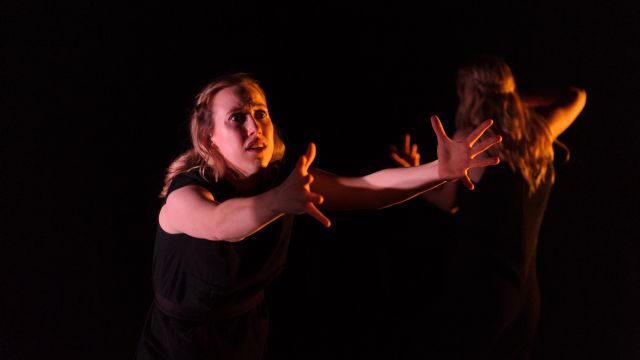The Three Graces
On a rectangle of bright, white sand, three women recreate (more or less) the famous 1817 statue by Canova of ‘The Three Graces’ of classical antiquity – Euphrosyne, Aglaia and Thalia. Mirth, Elegance and Beauty. The actors are Candace Miles, Anna Rodway and Madelaine Nunn.
Well, it’s not quite Canova’s classicism: in the statue, the three figures are, of course, naked and the three women on stage are dressed in black and have eschewed the marble look white make-up they used in their publicity material. Here, these ‘Three Graces’ adorn a fountain – but there is no water. That is, they have been ‘preserved’ from the past, but occupy a dry place, decorative figures on a non-functioning ‘feature’. As the trio comes to life they wonder, what is the place and influence of these daughters of Zeus, ‘preserved’ certainly, but are they irrelevant?
The premise is an interesting one even if it’s a bit of a stretch. (After all, on Olympus, the Graces were not much more than hostesses.) Playwright Laura Lethlean claims in her program note that these Graces can ‘give voice to the inner dialectic that we all possess’ [sic], but it’s not entirely clear why they can. Rather than being ‘carved from the epic traditions of Greek theatre’ (a dubious claim made in the publicity blurb), The Three Graces states its case, but rarely dramatizes it, and, despite an innovative text and direction, the case it states is unfortunately nothing new. The play continues with a series of set pieces and ideas that question the present place, role and the future of women – ideas conveyed in at times heightened poetic dialogue, expressive often disturbing choreography and stylised scenes with naturalistic dialogue.

Women have been told they are ‘liberated’, the ‘best educated generation’ and that they ‘can have it all’ – but here it’s established that that is still difficult if not outright untrue. What is the ‘all’ they might have anyway when the planet faces an uncertain future? We witness, for instance, increasingly heated argument between two artists, one of whom has put her ‘career’ on hold to have children, a decision her focussed (blinkered?) colleague regards with something bordering on contempt.
The sand they stand on begins to suggest a desert, and lighting designer Rachel Lee’s cunning trick of running hidden lights under the sand works extremely well, suggesting ice and fire. There are some difficulties, however, in delivering this brave excursion into mixed modes of theatre. Director Katie Cawthorne has taken on a challenging task, and says, ‘this work is complex’. It is and I wonder if, leaving aside the naturalistic scenes, the concepts are rather too complex to be conveyed in these forms? The three actors themselves give their roles intensity but seem not entirely at ease with the poetic, incantatory speeches – or at times, with their stylised movements. At almost ninety minutes, given these issues, and that the play verges on highfalutin agit-prop, I’d question whether the concentration and patience of the audience just might be tested too far.
Michael Brindley
Photographer: Sarah Walker
Subscribe to our E-Newsletter, buy our latest print edition or find a Performing Arts book at Book Nook.

